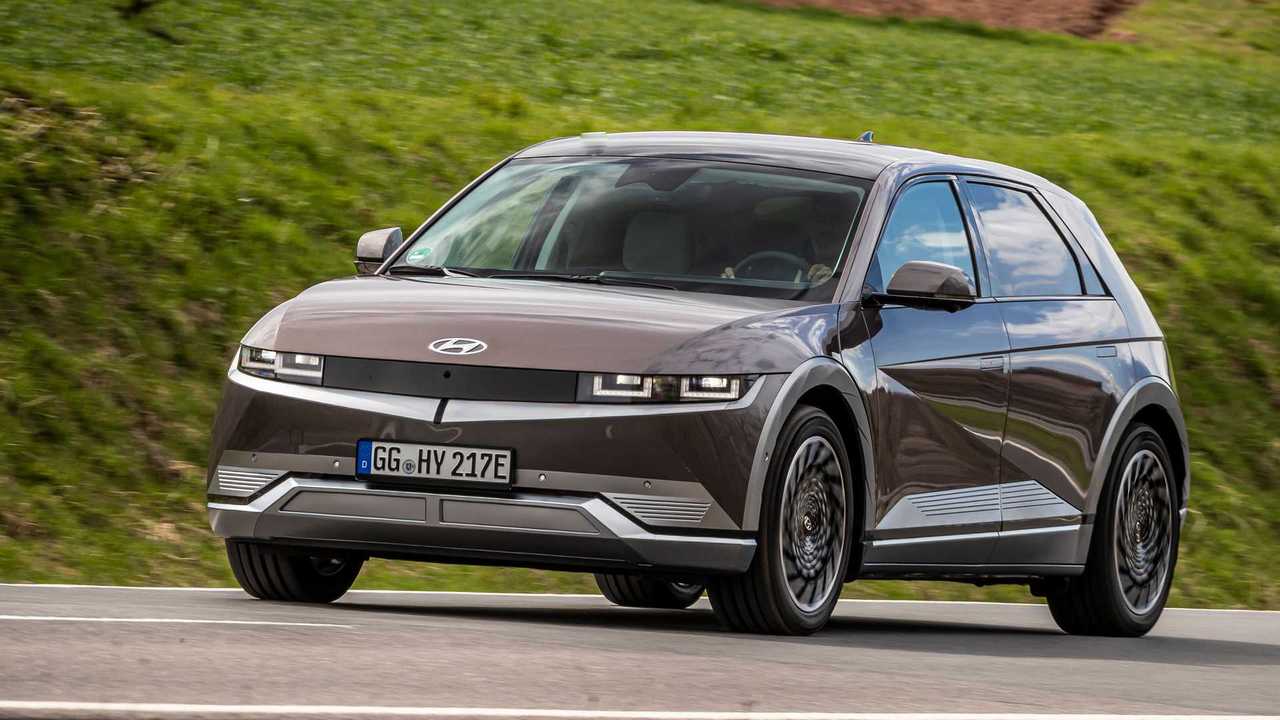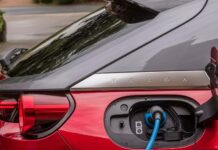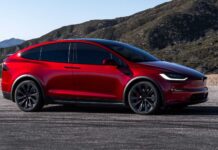[ad_1]
Today we will take a look at the fast charging capability of a pre-production prototype of the upcoming Kia EV6, which earlier this month was tested by Out of Spec Reviews‘ Kyle Conner in Germany.
The Kia EV6 is based on the same E-GMP platform as the Hyundai Ioniq 5, which is a fast charging titan, so we expect a similarly great performance from the EV6 as well.
However, the Kia EV6 has a different battery than the European Ioniq 5 (77.4 kWh according to Kia). The all-wheel-drive car is expected to offer a WLTP range of 506 km (314 miles). The rear-wheel-drive version should be able to go about 4% further on a single charge – 528 km (328 miles).
Kyle Conner conducted multiple tests at IONITY fast chargers, noting a highly volatile charging curve (even more volatile than in the Hyundai Ioniq 5). The first one, on which we will focus, is the 0-100% State of Charge (SOC) test with a pre-conditioned battery temperature. The second one in the video, starts at 40% SOC.
Let’s get into details.
The test reveals that the charging power almost immediately starts to increase above 200 kW, before even reaching 2% SOC. That’s really awesome, especially since the highest power output was maintained up to about 46% SOC.
The peak charging power is about 233 kW (we even saw 234 kW for an ultra short while).
The things get complicated after at 46% SOC, when the power output starts to decrease – in instant steps – reaching about 186 kW at 47% SOC, then 116 kW at 58% SOC and finally 30 kW at 63% SOC. That’s an extraordinary sight.
Not only that. Then, the power output increases in a very short time up to over 191 kW at 66% SOC, and starts to decrease more linearly from then. Around 78% SOC it hits a 62 kW dip, and another one of just 6 kW at 82 SOC.
The good thing is that even at 92% SOC, the power was above 50 kW, and about 20 kW at 98% SOC.
We assume that the hardware and software in the pre-production prototype of the Kia EV6 is simply raw and over-sensitive to temperatures inside the battery pack. If Kia manages to smooth the charging curve, so it would gradually decrease from 46% SOC, it will be one of the best on the market right now.

Depending on the starting point and initial battery temperature, the charging curve might vary.
The entire charging session (0-100% SOC), according to the charger, took about 48 minutes. Charging from 20% to 80% SOC took about 18 minutes.
The weak point is the 82% SOC, when the car stuck for 4 minutes or so at 6 kW. An obvious thing to improve in the production version.
Kia says that the production car in optimum conditions will need 18 minutes (see European and U.S. specs) to recharge from 10-80% SOC at an 800 V ultra-fast charger with a peak of 239 kW and that 100 km (62 miles) of range can be replenished in 4.5 minutes.
The chart below is only for illustrative purposes:

The average power in the very important range from 20% to 80% SOC is 151 kW, which is 65% of the peak value.
That’s already one of the best results on the market and we assume it will be noticeably better in the production car (at least 170 kW).

Kia says that the EV6 is equipped with a 77.4 kWh but does not explain whether it’s usable or total capacity. The charger indicates that the car consumed 81.6 kWh, which might be 77.4 kWh of usable capacity and 4.2 kWh of losses (95% efficiency). If the 77.4 kWh would be the total value and the net capacity would be lower, then it would mean that the losses are even higher, like 8 kWh or 10% (sounds high).
For the sake of today’s analysis,we will assume that the total battery capacity is 82 kWh and 77.4 kWh is net usable.
The peak C-rate* – charging power in relation to the total battery capacity of 82 kWh – would be over 2.8C. The average C-rate when charging from 20% to 80% SOC is 1.85C. Those are among the highest values in the industry.
*C-rate tells us how the charging power relates to the battery pack capacity. For example: 1C is 1-hour charging power (current), when the power value in kW is equal to the battery pack capacity in kWh. 2C would be enough to recharge in half an hour.
The net battery capacity of 77.4 kWh would stand for about 94% of the total battery capacity.

The rate of range replenishing depends on the energy consumption and the energy consumption depends on the use case.
The tested prototype is an AWD car (the RWD is expected to have 4% more range and thus 4% higher range replenishing speed).
- WLTP
Taking into consideration the WLTP range of 506 km (314 miles) and available battery capacity of 77.4 kWh, we can assume energy consumption of 153 Wh/km (246 Wh/mile).
The effective average speed of range replenishing when charging from 20% to 80% SOC would be then 16.5 km/minute (10.3 miles/minute).
The average result here is one of the best and might improve to the Hyundai Ioniq 5 level after the charging curve is improved.

Comparisons with other EVs

Kia EV6 fast charging at IONITY

Hyundai Ioniq 5 (2021)
As the tested Kia EV6 is a prototype, we will take a look only at the comparison with the Hyundai Ioniq 5 (72.6 kWh battery version) – the one tested by Battery Life and by Hyundai itself (demo).
Let’s note also that the U.S. version of the Hyundai Ioniq 5 will have the same battery capacity as the Kia EV6 (77.4 kWh), while in Europe there are two other versions (58.2 and 72.6 kWh).
We complained a little bit about the dips in the Hyundai Ioniq 5’s charging curve, but in the pre-production prototype of the Kia EV6 it’s even worse.
On the other hand, the EV6 has much better charging output in the beginning! Assuming that the red line will be smoothened, the Kia EV6 has clear potential to beat the Hyundai Ioniq 5.

As of today, the average power in the 20-80% SOC window is better in the Hyundai Ioniq 5:
| DC Fast Charging Comparison by InsideEVs | |||
| Model [data source] |
Drive / Battery (kWh) |
Max Power |
Avg Power (20-80%) |
| 2021 Kia EV6 Prototype (77.4 kWh, AWD) [Out of Spec Reviews] |
AWD 82 kWh |
233 kW | 151 kW |
| 2021 Hyundai Ioniq 5 (72.6 kWh) [Battery Life] |
AWD 77 kWh |
224 kW | 170 kW |
| 2021 Hyundai Ioniq 5 (72.6 kWh) (Hyundai’s demo) [Hyundai] |
AWD 77 kWh |
225 kW | 180 kW |
The C-rate comparison is tricky, as we don’t know for sure the total battery capacity number, but it appears that they are comparable.

| DC Fast Charging Comparison by InsideEVs | ||||||
| Model [data source] |
Drive / Battery (kWh) |
Max Power |
Avg Power (20-80%) |
Max C-Rate |
Avg C-Rate (20-80%) |
Time (20-80%) |
| 2021 Kia EV6 Prototype (77.4 kWh, AWD) [Out of Spec Reviews] |
AWD 82 kWh |
233 kW | 151 kW | 2.8 | 1.9 | 18 min |
| 2021 Hyundai Ioniq 5 (72.6 kWh) [Battery Life] |
AWD 77 kWh |
224 kW | 170 kW | 2.9 | 2.2 | 15 min |
| 2021 Hyundai Ioniq 5 (72.6 kWh) (Hyundai’s demo) [Hyundai] |
AWD 77 kWh |
225 kW | 180 kW | 2.9 | 2.3 | 15 min |
The Kia EV6 replenishes range faster than the Hyundai Ioniq 5, but then is affected by the quirks in the charging curve.

Overall, in the 20-80% SOC window, Kia EV6 is slower than the Hyundai Ioniq 5, but with a potential to be quicker in the final production version.
| DC Fast Charging Comparison by InsideEVs | |||
| Model [data source] |
Drive / Battery (kWh) |
Avg Power (20-80%) |
WLTP range rep. rate (20-80%) |
| 2021 Kia EV6 Prototype (77.4 kWh, AWD) [Out of Spec Reviews] |
AWD 82 kWh |
151 kW | 16.5 km/min 10.3 mi/min |
| 2021 Hyundai Ioniq 5 (72.6 kWh) [Battery Life] |
AWD 77 kWh |
170 kW | 18.8 km/min 11.7 mi/min |
| 2021 Hyundai Ioniq 5 (72.6 kWh) (Hyundai’s demo) [Hyundai] |
AWD 77 kWh |
180 kW | 19.9 km/min 12.4 mi/min |
Overall, the Kia EV6 in its pre-production prototype version appears to be a diamond that needs to be polished. The charging results are already very good.
If the manufacturer will tweak the charging system, which is probably over-sensitive to battery temperatures (or voltage), it should become state-of-the-art in terms of charging speed, at least on par with the Hyundai Ioniq 5.
We look forward to test and analyze the final product that in Europe and South Korea will be delivered to customers .
| 2021 Kia EV6 Prototype (77.4 kWh, AWD) :: DC Fast Charging Summary by InsideEVs Drive: AWD; Battery pack (net / total): 77.4 / 82 kWh [Data source: Out of Spec Reviews] |
|
| Peak Power Peak C-rate Average Power (20-80% SOC) Time (20-80% SOC) |
233 kW 2.8 151 kW 18 min |
| Range Replenishing Speed (Average 20-80% SOC): | |
| WLTP | 16.5 km/min (10.3 mi/min) |
General info:
* Some values on the charts are estimated from the data source.
** Temperature of the battery cells might highly negatively affect charging capabilities. We don’t have data about temperatures of the battery at the beginning and during the charging process. In cold or hot weather, as well as after driving very dynamically, charging power might be significantly lower than shown on the charts (in extreme cases charging might be impossible until the battery temperature will not return to an acceptable level).
[ad_2]
Source link













